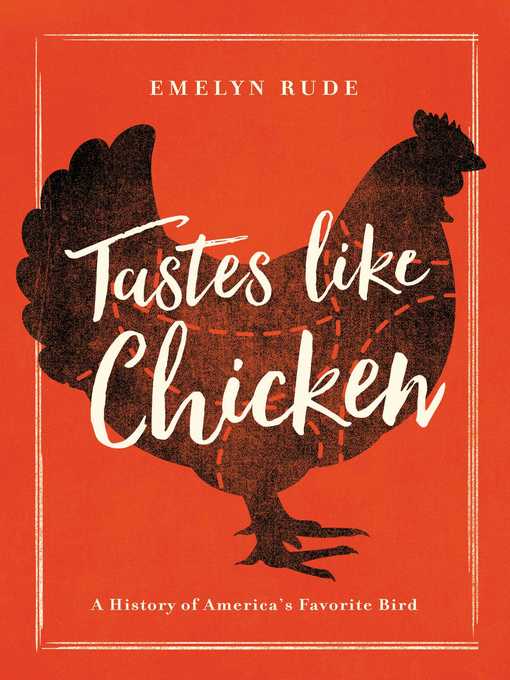
Tastes Like Chicken
A History of America's Favorite Bird
کتاب های مرتبط
- اطلاعات
- نقد و بررسی
- دیدگاه کاربران
نقد و بررسی

June 27, 2016
In this largely bland culinary history, food writer Rude plucks the bird clean to the bone as she traces the rise of America’s culinary love of the chicken from the 15th century, through and Colonial times, and up to the early 21st century. In 2015, the average American ate more than 90 pounds of chicken, or 23 birds a person, which adds up to 8.6 million chickens being consumed over the course of a year. According to Rude, the chicken wasn’t always quite so popular: in the early 20th century, roasted chicken might have been the centerpiece of Sunday dinner, but Americans ate only about 10 pounds of chicken each year. As she examines these changes, she provides recipes for various chicken dishes that illustrate diverse ways of preparing the fowl at various times and circumstances in American history: for example, chicken salad grew in popularity in the 19th century era among wealthy Americans, who drank champagne as an accompaniment. The kosher chicken business became contentious in early-20th-century New York. Chicken consumption soared in the 1940s, thanks to John Tyson and Jesse Jewell, among others, who found ways to industrialize the process of raising chickens. Rude concludes that no matter the issues surrounding the raising of chickens in the 21st century—free-range versus caged, antibiotic and hormone-free versus not—Americans now consume chicken more than ever. Agent: Peter Steinberg, Foundry Literary + Media.

Starred review from July 1, 2016
In her first book, a food historian with a feature writer's flair illuminates the culinary history of the now-ubiquitous chicken.Though the chicken would seem to be a subject that everybody knows about, Rude makes the humble bird's story fresh and interesting on nearly every page. "Painted in broad strokes," writes the author in the introduction, "this is a story of agricultural science and human health, of the economics of feeding a nation and the politics that encircle the making and eating of a food. But on a more intimate level, this is really just the story of dinner." From chicken soup to chicken nuggets and from "chicken" as a synonym for coward to "a chicken in every pot" as a campaign slogan for prosperity, Rude covers chicken from practically every possible angle and perspective, showing how the bird that was once used mainly for its eggs and feathers now outdistances beef and pork (the "Other White Meat") in American preference and how it has gone from a high-priced extravagance to a mass-produced bargain. Readers will learn about the 1920s "great Chicken Wars" that rivaled bootlegging in their bloodshed, about the "millions of mail-order chicks" delivered by the postal service, and about the development of "chicken eyewear" and even contact lenses to prevent the birds from pecking each other to death. There's an unsung hero in Robert Baker, the "poultry savant, a chicken Thomas Edison," whose legacy extends to the Chicken McNuggets boom, and Rude offers an intriguing analysis of the cross-cultural relationship between Colonel Sanders (beloved in China and Japan) and General Tso. There is also a more serious examination of the "deadly risks" in the mass production of chicken, including E. coli and salmonella. All this from an author who admits, "I am a chicken historian who does not actually like eating chicken," but who finds the bird as fascinating as she makes it for readers.
COPYRIGHT(2016) Kirkus Reviews, ALL RIGHTS RESERVED.

August 1, 2016
Americans are the most prolific eaters of chicken, consuming an average of 90 pounds per person in 2015. But our taste for chicken is a relatively new phenomenon. Journalist Rude traces the factors that contributed to this rise in popularity, beginning with chickens' domestication in Asia over 10,000 years ago up to today's modern, sprawling industry. Until the early 1900s, beef was king of the American plate. When slaves made fried chicken and sold it to passing soldiers during the Civil War, the trend increased, but its high price kept it out of reach for most. The 1920s saw the awakening of calorie consciousness and dieting, which led to a growth in fowl as a lower calorie option. After the first commercial chicken hatchery and the emergence of the broiler industry, prices dropped drastically, making it more affordable. As chicken became the favored meat, practices became standardized, creating social, environmental and ethical issues that continue to trouble the marketplace. VERDICT Readers of food histories such as Mark Kurlansky's Cod will appreciate this engaging, well-researched, and thorough history of America's changing food preferences.--Melissa Stoeger, Deerfield P.L., IL
Copyright 2016 Library Journal, LLC Used with permission.

























دیدگاه کاربران